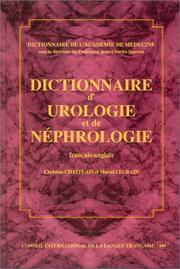| Listing 1 - 10 of 12 | << page >> |
Sort by
|
Book
Year: 1977 Publisher: Paris Masson
Abstract | Keywords | Export | Availability | Bookmark
 Loading...
Loading...Choose an application
- Reference Manager
- EndNote
- RefWorks (Direct export to RefWorks)
Dissertation
Abstract | Keywords | Export | Availability | Bookmark
 Loading...
Loading...Choose an application
- Reference Manager
- EndNote
- RefWorks (Direct export to RefWorks)
Book
Year: 1963 Publisher: Paris A. G. E. M. P
Abstract | Keywords | Export | Availability | Bookmark
 Loading...
Loading...Choose an application
- Reference Manager
- EndNote
- RefWorks (Direct export to RefWorks)

ISBN: 285319289X 9782853192897 Year: 2001 Publisher: Paris : Conseil International de la Langue Française (CILF),
Abstract | Keywords | Export | Availability | Bookmark
 Loading...
Loading...Choose an application
- Reference Manager
- EndNote
- RefWorks (Direct export to RefWorks)
Urology --- French language --- Nephrology --- Urologie --- Français (Langue) --- Néphrologie --- Dictionaries --- French --- English --- Dictionary --- Dictionnaires français --- Dictionnaires anglais --- Dictionaries, Medical --- Nierziekten --- Ziekten van de geslachtsorganen --- Ziekten van de urinewegen --- woordenboeken --- woordenboeken. --- Woordenboeken. --- Français (Langue) --- Néphrologie --- Dictionnaires français --- French. --- Urology - dictionary --- Nephrology - dictionary
Book
Year: 1989 Publisher: Paris TI
Abstract | Keywords | Export | Availability | Bookmark
 Loading...
Loading...Choose an application
- Reference Manager
- EndNote
- RefWorks (Direct export to RefWorks)
Applied physical engineering --- economie --- energie (technologie) --- optimalisatie
Book
ISBN: 222581399X Year: 1988 Publisher: Paris Barcelone Mexico Masson
Abstract | Keywords | Export | Availability | Bookmark
 Loading...
Loading...Choose an application
- Reference Manager
- EndNote
- RefWorks (Direct export to RefWorks)
Book
ISBN: 2225808317 Year: 1986 Publisher: Paris Barcelone Mexico Masson
Abstract | Keywords | Export | Availability | Bookmark
 Loading...
Loading...Choose an application
- Reference Manager
- EndNote
- RefWorks (Direct export to RefWorks)
Book
ISBN: 2225810990 Year: 1987 Publisher: Paris Barcelone Mexico Masson
Abstract | Keywords | Export | Availability | Bookmark
 Loading...
Loading...Choose an application
- Reference Manager
- EndNote
- RefWorks (Direct export to RefWorks)
Book
Year: 2015 Publisher: Bruxelles: UCL. Faculté de pharmacie et des sciences biomédicales,
Abstract | Keywords | Export | Availability | Bookmark
 Loading...
Loading...Choose an application
- Reference Manager
- EndNote
- RefWorks (Direct export to RefWorks)
Chronic lymphocytic leukemia is the most common leukemia in adults. Despite its status as a rare disease, the development of new treatments is booming. For about twenty years now, monoclonal antibodies have revolutionized the treatment of cancers. The first monoclonal antibody discovered was the rituximab, this one targeting the CD20 antigen found on the membrane of B Lymphocytes. They are a lot of them in chronic lymphocytic leukemia; it will prove that the treatment was effective in this disease. Following this discovery, the researchers go beyond and try to obtain more effective monoclonal antibodies. What treatments are available for patients with chronic lymphocytic leukemia? What are the benefits of targeted therapy? How did we come to monoclonal antibodies? And especially what improvements brings Gazyva ? La leucémie lymphoïde chronique est la leucémie la plus fréquente chez les adultes. Malgré son statut de maladie rare, le développement de nouveaux traitements est en pleine expansion. Depuis une vingtaine d'années, les anticorps monoclonaux ont révolutionné la thérapeutique des cancers. Le premier anticorps monoclonal découvert fut le rituximab, celui-ci ciblait l'antigène CD20 présent sur la membrane des lymphocytes B. Ces derniers étant très nombreux dans la leucémie lymphoïde chronique, il s'avèrera que le traitement était efficace dans cette maladie. Suite à cette découverte, les chercheurs se dépassent et tentent d'obtenir des anticorps monoclonaux de plus en plus efficace. Quels sont les traitements disponibles pour les patients atteints de leucémie lymphoïde chronique ? Quelles sont les avantages d'une thérapie ciblée ? Comment en sommes-nous arrivés aux anticorps monoclonaux ? Et surtout quelles améliorations apporte le Gazyva® ?
obinutuzumab --- Antibodies, Monoclonal, Humanized --- Leukemia, Lymphoid
Book
Year: 2001 Publisher: Bruxelles: UCL,
Abstract | Keywords | Export | Availability | Bookmark
 Loading...
Loading...Choose an application
- Reference Manager
- EndNote
- RefWorks (Direct export to RefWorks)
In clinical practice, the use of platelet transfusion has increases progressively. A common complication is platelet alloimmunization, a major cause for refractoriness to repeated platelet transfusions. Therefore several attempts mere made to produce autologous platelets in-vitro to prevent this complication.
In this study, we were able to produce platelets in-vitro from cultured human peripheral blood stem cells (DC34+) in liquid culture medium that promotes megakaryocytopoiesis and thrombocytopoiesis.
Cells in culture did show a high proliferative capacity throughout the culture days, with megakaryocytic proliferation and differenciation, in the presence of growth factors that stimulate megakaryocytopoiesis and thrombocytopoiesis (rh-TPO, rh-IL-3, rh-IL-6, and rh-IL-11).
The megakaryocytic cells were identified by flow cytometry as CD61+ cells with scatter properties of nucleated cells, by morphology, by immunocytochemistry. MKs were first observed in culture medium from 7 days, many of them releasing proplatelets. They reached a peak on day 14. Thereafter cells disappeared from the culture medium. Most of the MKs did not show a ploidy of more than 4N by our measurement methodology and only a very few proportion of them reached 8N.
Culture-derived were detected as CD41+ events and shared the same scatter properties of normal blood platelets in flow cytometry. Although they are successfully produced in culture, they seem to be somewhat activated since expression of P-selectin (GMP 140; CD62+) detected by flow cytometry, a finding that makes their clinical use still questionable. They appeared from day 7 and reached a peak on day 14.
In summary, we settled a technology for producing platelets in in-vitro culture. These platelets show characteristics of normal platelets; however, more experiments are required in order to improve their rate of production and to obtain a normal function
| Listing 1 - 10 of 12 | << page >> |
Sort by
|

 Search
Search Feedback
Feedback About
About Help
Help News
News